Performing spay surgery on a bitch is one of the most common surgeries undertaken at first opinion veterinary practices. It is also one of the most controversial surgeries, with many people (veterinary surgeons, nurses and lay people) having firm views on three main aspects:
Sadly, there is no one answer to all these questions, so some controversy must necessarily remain: however, a review of some of the literature may help the practice nurse advise clients better on their neutering decisions.
Should we spay?
In Sweden, until 2012 it was illegal to spay a bitch (other than for a medical reason). Although that law has now been slightly relaxed, a study during that time showed that approximately 25% of bitches will have had pyometra (Figure 1) by the time they reach 10 years of age (Egenvall et al, 2001). Since pyometra is a potentially life-threatening illness, which can be prevented by spaying, this in itself may provide an argument for recommending spaying for all bitches. The British Veterinary Association (BVA) published a policy document in 2014 which ‘strongly supports the practice of …spaying of bitches’ (www.bva.co.uk/News-campaigns-and-policy/policy/Companion…/Neutering/). The policy document listed the benefits of spaying as: avoiding the potential distress of pseudopregnancy, removing the risk of pyometra, reducing the risk of mammary tumours and the cessation of oestrus (thus obviating the need for seclusion of a bitch while in heat).
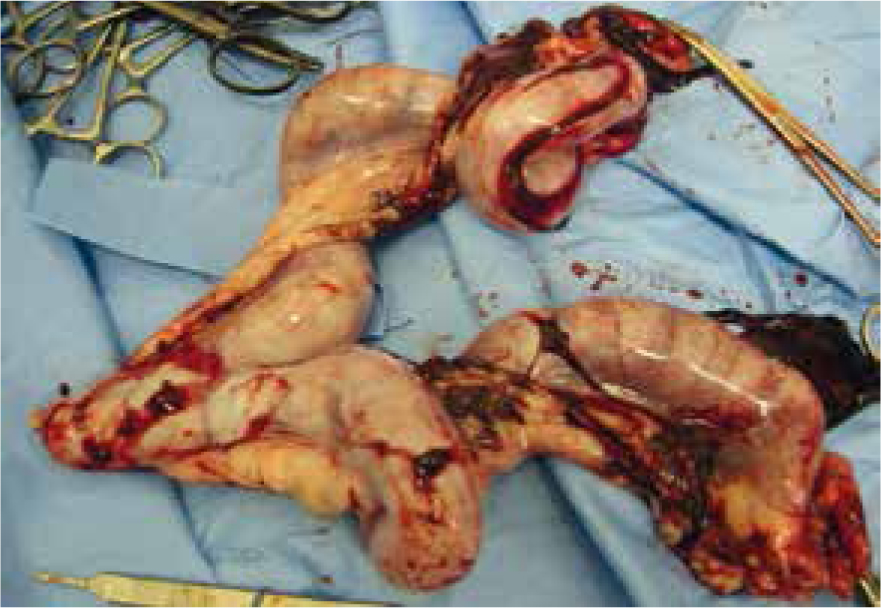
The document goes on to mention that there may be potential detriments to spaying, such as potential for weight gain and the possible increased risk of urinary incontinence, and states that ‘BVA acknowledges that neutering is not a trivial procedure but the welfare implications of neutering are outweighed by the benefits’.
Responsible dog ownership and responsible dog breeding seldom go hand-in-hand: figures from the Dogs Trust suggest that around 50 000 dogs are abandoned each year (https://www.bbc.co.uk/news/uk-34413490). Clearly, neutering will help reduce the risk of unwanted litters (although it will not necessarily improve responsible breeding).
In addition to the BVA's statement, other reputable organisations (e.g. the Kennel Club, RSPCA, Dog's Trust) strongly support spaying of bitches, but all suggest that the advantages and disadvantages should be weighed up in every individual case. There are few behavioural advantages of spaying (other than avoiding pseudopregnancy), but several often-stated medical advantages. Similarly, there are no published behavioural disadvantages of spaying, but several medical disadvantages. Let us consider these in turn.
Advantages
Stopping pseudopregnancy
Pseudopregnancy (‘false pregnancy’) is a normal part of the reproduction cycle of the bitch. Every bitch, whether mated or not, will undergo the same basic hormonal changes following oestrus, whether mated or not. Many bitches will even lactate following pseudopregnancy. Evolutionarily, this has allowed unmated females within packs of wolves to help ‘group suckle’ the pack's pups. Not so useful, however, for a Maltese Terrier that produces milk over her owner's chair cover: especially if the bitch in question is also displaying some of the behavioural changes frequently associated with pseudopregnancy (hoarding of toys, household implements and becoming aggressive if these are removed). Although medications exist to reduce the duration and effects of pseudopregnancy, spaying will prevent it completely. A relative contraindication to spaying during metoestrus exists, however; this can result in persistent (or at least prolonged) pseudopregnancy, and is the main reason for suggesting delaying neutering until at least 3 months following a season.
Reducing the risk of mammary neoplasia
One of the most often quoted benefits for spaying is that it will reduce the incidence of mammary tumours in the bitch (Figure 2). Although there is much literature suggesting that early spaying reduces the overall incidence of mammary tumours in the bitch (Schneider et al, 1969; Schneider, 1970; Sleeckx et al, 2011; Kustritz, 2014), a systematic review, of over 11 000 peer-reviewed journals (Beauvais et al, 2012a) could find no convincing evidence that neutering (at any age) reduces the risk or incidence of mammary neoplasia, although Arlt et al (2017) conclude that there is likely to be some benefit in early neutering (before the first season). Nor is it certain whether spaying at the time of removal of mammary tumours will reduce the risk of further tumours, or improve the prognosis; with some researchers finding positive results (Sorenmo et al, 2000), while others found little or no benefit (Morris et al, 1998). Unfortunately, the definitive work to prove this one way or the other has still to be done.
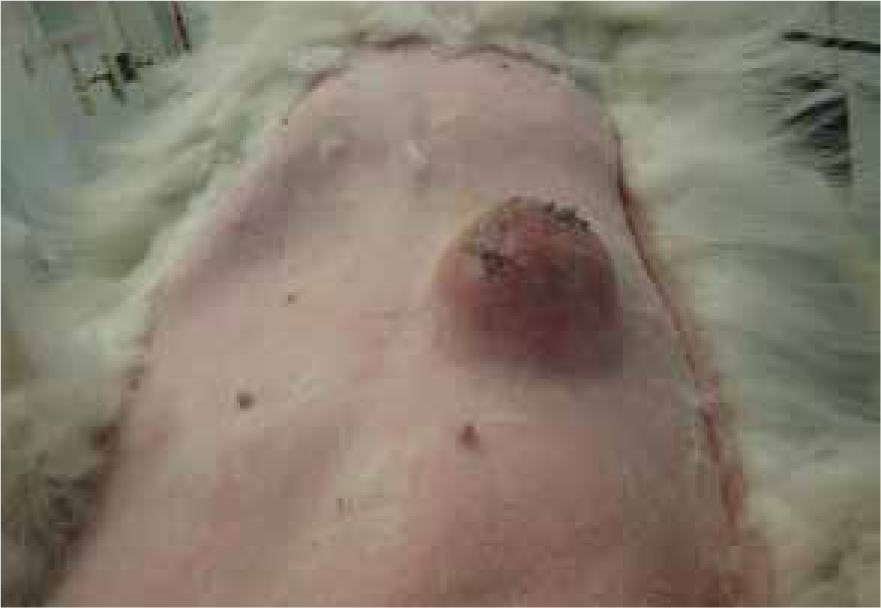
Longevity
Interestingly enough, it would appear that spaying increases the expected lifespan of a bitch (Michel, 1999; Hoffman et al, 2013; Howe, 2015). The average lifespan of a bitch may well increase by a little over 1 year if spayed (O'Neill et al, 2013), although this seems to depend very much on dog breed and size. It is uncertain what is responsible for the increased lifespan, although changes to telomere length (a part of the chromosome that is responsible for ageing changes) in neutered or nulliparous individuals has been postulated (Perls et al, 2002).
Disadvantages
Urinary incontinence
It is commonly accepted that spaying increases the risk of urinary incontinence: there are several studies ranging from the late 1980s to the present that appear to substantiate this (Arnold et al, 1989; Stocklin-Gautschi et al, 2001; Veronesi et al, 2009; Forsee et al, 2013). Most papers suggest that the risk of urinary incontinence post spaying is greater in dogs larger than 20 kg (Angioletti et al, 2004; van Goethem et al, 2006), and younger than 3–6 months at the time of neutering; although there is conflicting evidence even in individual papers (Howe, 2015; Hart et al, 2016).
However, a systematic review of clinical papers by Beauvais et al in 2012 found only weak statistical evidence to suggest that spaying at any age increased the risk of urinary incontinence, and concluded that present evidence is not strong enough to provide any recommendation on the best age to perform spay to avoid incontinence, or even whether spaying causes urinary incontinence.
Obesity
Again, the general consensus among the veterinary populace and the public is that spaying can increase the risk of obesity in bitches. Although it is hard to find good evidence for this in the literature, a study by Lefebvre et al (2013) found that the risk of weight gain post spaying was only present in the first 2 years after neutering, and that age at neutering did not affect the propensity for weight gain. It would thus seem sensible to advise owners to pay particular attention to their pet's weight in the first 2 years after neutering.
Increased risk of other diseases
Various studies have shown that spaying can increase the relative risk of various cancers, such as osteosarcoma, mast cell tumour, lymphosarcoma and haemangiosarcoma (Hoffman et al, 2013; Howe, 2015), and also increases the risk of bone and joint disease such as cranial cruciate ligament rupture (Wilke, et al, 2002; Torres de la Riva et al, 2013). However, it is important to bear in mind that these increases in risk are small, and amount to a few percent rise in the incidence of these diseases. It is also important to bear in mind that there are very likely breed-specific relative risks (Torres de la Riva et al, 2013), and we cannot at present generalise on risks for all dog breeds. It is also worth noting that all of these findings are retrospective studies and cannot reliably demonstrate a causal link between spaying and risk of developing health problems.
The lack of conclusive data which represent all breeds of dog makes it difficult to fully advise clients on the pros and cons of spaying. However, as mentioned above, the clients must be made aware that there are potential risks, many of which are unknown as yet, and the decision to spay or not spay must be made on the overall balance of evidence.
What is the optimum age for spaying?
Unfortunately, there is little agreement in the available literature on the optimum age for spaying. As mentioned above, the evidence for reduction in mammary tumours when spaying prepubertal bitches is scant, but there may be some merit in doing so (Arlt et al, 2017). Similarly, the risks of post spay urinary incontinence are not fully known (Beauvais et al; 2002), although the general recommendation is to delay spaying until after 3–4 months in some breeds (Howe, 2015), possibly later than 12 months in certain larger breeds (Hart et al, 2016). Again, both of these studies were retrospective, and dealt with quite restricted populations of bitches, so the evidence is far from conclusive. It would make sense that bitches in rescue centres should be considered for juvenile spaying, as this reduces the risk of unwanted litters; it is less clear what advice to give private owners. The author currently advises his clients to consider juvenile spaying (3 months onwards) for bitches whose ultimate weight is likely to be <15 kg, and 6 months of age for those with an expected adult weight of >15 kg.
Ovariohysterectomy or ovariectomy?
There is some argument as to whether the word spay refers to full ovariohysterectomy (Figure 3), or simply removal of the ovaries. However, most owners understand it to mean removal of the ovaries and uterus. Removal of the ovaries alone (ovariectomy) has been shown to be slightly quicker and require a smaller incision (van Goethem et al, 2006; de Tora and McCarthy, 2011), unless performed by inexperienced surgeons (Harris et al, 2013). There is an argument that inexperienced surgeons may obtain more tissue handling and ligature practice by performing full ovariohysterectomies: there may also be a reduced risk of retained ovarian tissue in these cases. An argument often put forward against ovariectomies is the perceived risk of ‘stump’ pyometra (that is pyometra of the uterine remnant). However, pyometra is a sequel of cystic endometrial hyerplasia; a condition that can only develop in bitches with active ovarian tissue (or else those to whom exogenous oestrogen are administered) (Sontas et al, 2007). Thus, provided the ovaries are removed, there is no risk of pyometra (Adin, 2011).
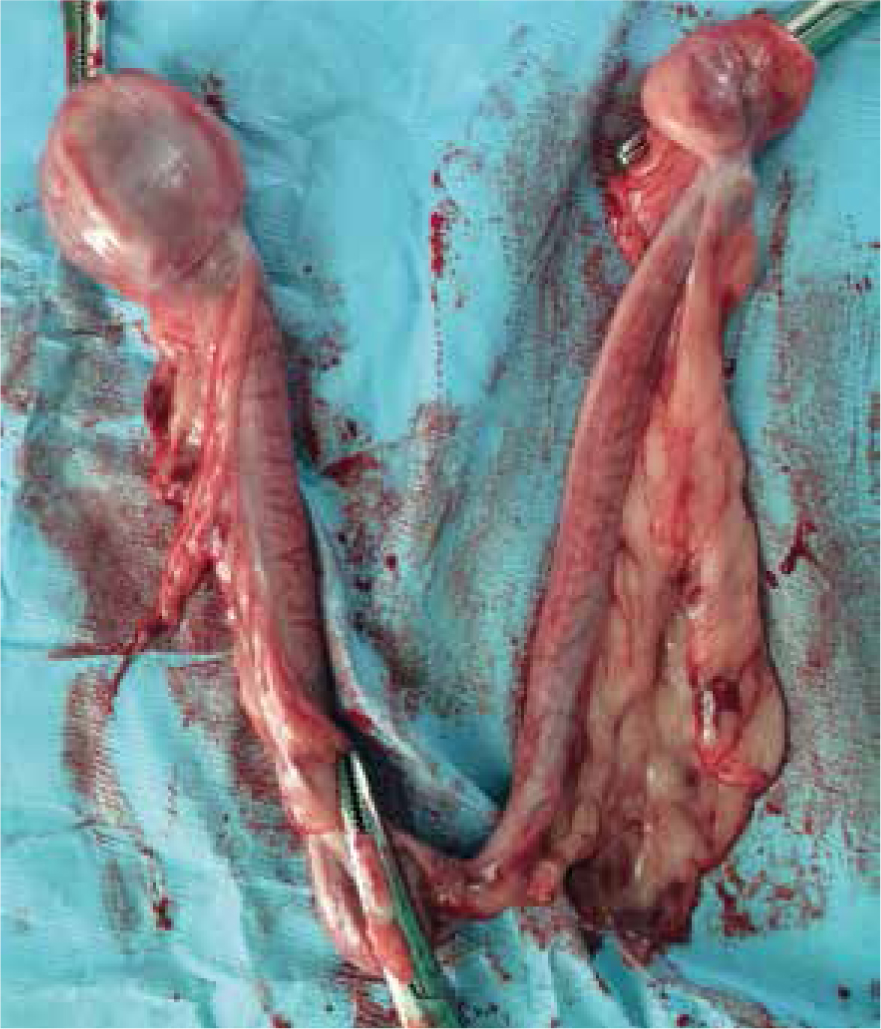
This is important, as there is an increasing trend to laparoscopic (Figures 4 and 5), or ‘keyhole’ spaying, which most commonly involves ovariectomy. There are various advantages to laparoscopic spaying (Corriveau et al, 2017; Nylund et al, 2017): perhaps most importantly the reduced need for post-operative resting and lead walking. In most cases, the bitch may exercise off the lead from 24–48 hours post surgery. The procedure seems to be less painful, also; possibly due to reduced traction on the ovarian ligament.
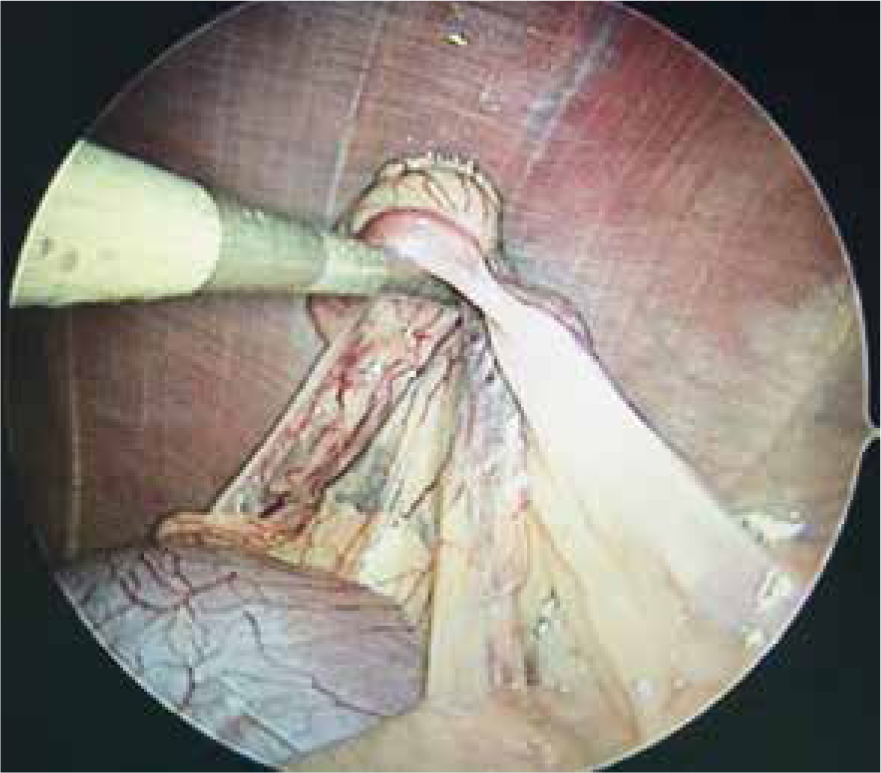
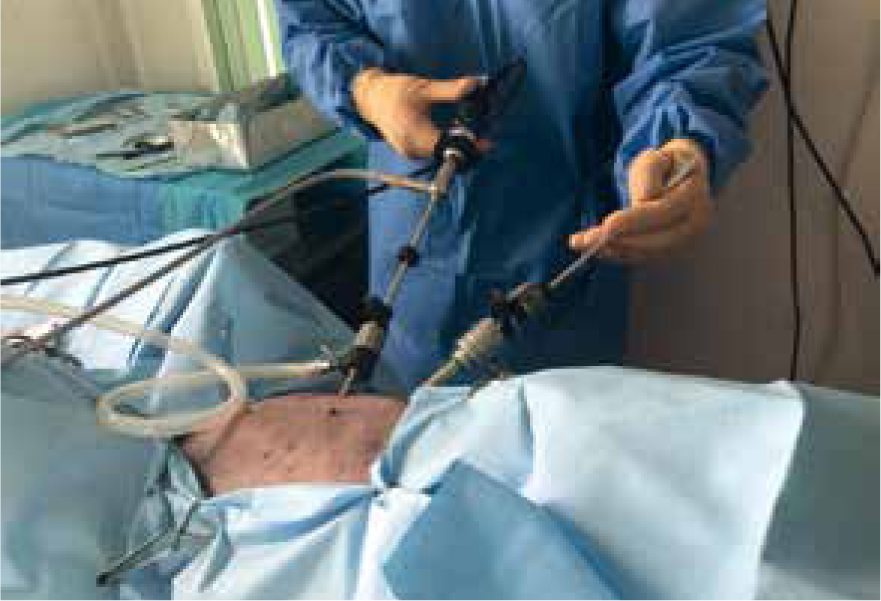
Conclusion
Spaying is a very common procedure in the UK (Diesel et al, 2010) and confers very obvious advantages (reduction of unwanted litters, prevention of pseudopregnancy, cessation of oestrus and prevention of pyometra). Other advantages such as reduction in mammary tumours have yet to be conclusively proven. On the other hand, there may be an increased risk of certain tumours, orthopaedic diseases and obesity; possibly also of urinary incontinence. There is little consensus on the optimum timing of spaying: ultimately this may well be dependent on breed and other factors. However, the choice of whether to perform a full ovariohysterectomy, or an ovariectomy, appears to be amenable to personal preference and practice policy: there seems to be no difference in outcome between the two.
At the moment, it is difficult to recommend a universal policy on spaying. Any discussion with a client or owner must take into account the client's wishes and expectations, as well as the experiences and preferences of the practice. In general, the benefits of spaying outweigh the risks.

